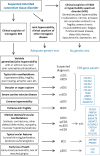Genetic diagnosis of the Ehlers-Danlos syndromes
- PMID: 39629471
- PMCID: PMC11610442
- DOI: 10.1515/medgen-2024-2061
Genetic diagnosis of the Ehlers-Danlos syndromes
Abstract
The Ehlers-Danlos syndromes (EDS) represent a group of genetically diverse disorders characterized by the variable combination of joint hypermobility, hyperextensibility of the skin, and connective tissue fragility affecting the skin and other organs. Based on clinical features, 13 different types of EDS have been delineated, 12 of which represent monogenic conditions caused by pathogenic variants in 21 confirmed genes. Pathogenesis is related to disturbances of collagen formation and/or stability. No monogenic cause has been identified for hypermobile EDS (hEDS), a more common EDS type, which is unlikely to represent a single gene disorder in the majority of affected individuals and at present cannot be diagnosed by genetic investigations. Here we summarize the clinical features and the molecular bases of the monogenic EDS types, highlight diagnostic challenges, and provide guidance for the molecular work-up of affected individuals. In general, genetic tests are indicated if clinical features suggest a monogenic EDS type but are usually unrewarding for other cases of hypermobility.
Keywords: EDS; Ehlers-Danlos syndrome; gene panel; genetic testing; hypermobility; organ rupture; skin fragility; skin hyperextensibility.
© 2024 the author(s), published by De Gruyter.
Conflict of interest statement
Competing interests: Authors state no conflict of interest.
Figures
Similar articles
-
Hypermobile Ehlers-Danlos syndromes: Complex phenotypes, challenging diagnoses, and poorly understood causes.Dev Dyn. 2021 Mar;250(3):318-344. doi: 10.1002/dvdy.220. Epub 2020 Aug 17. Dev Dyn. 2021. PMID: 32629534 Free PMC article. Review.
-
Clinical diagnosis of the monogenic Ehlers-Danlos syndromes.Med Genet. 2024 Dec 3;36(4):225-234. doi: 10.1515/medgen-2024-2060. eCollection 2024 Dec. Med Genet. 2024. PMID: 39629459 Free PMC article.
-
Diagnostic outcomes for molecular genetic testing in children with suspected Ehlers-Danlos syndrome.Am J Med Genet A. 2022 May;188(5):1376-1383. doi: 10.1002/ajmg.a.62672. Epub 2022 Feb 6. Am J Med Genet A. 2022. PMID: 35128800
-
Hypermobile Ehlers-Danlos Syndrome: Diagnostic Challenges and the Role of Genetic Testing.Genes (Basel). 2025 Apr 29;16(5):530. doi: 10.3390/genes16050530. Genes (Basel). 2025. PMID: 40428350 Free PMC article.
-
Dermatologic manifestations and diagnostic assessments of the Ehlers-Danlos syndromes: A clinical review.J Am Acad Dermatol. 2023 Sep;89(3):551-559. doi: 10.1016/j.jaad.2023.01.034. Epub 2023 Feb 8. J Am Acad Dermatol. 2023. PMID: 36764582 Review.
Cited by
-
Affect Regulation Capabilities in Hypermobility Ehlers Danlos Syndrome: Exploring the Associations with Pain Perception and Psychophysical Health.Brain Sci. 2025 Feb 15;15(2):202. doi: 10.3390/brainsci15020202. Brain Sci. 2025. PMID: 40002533 Free PMC article.
References
-
- Alazami AM, Al-Qattan SM, Faqeih E, Alhashem A, Alshammari M, Alzahrani F, Al-Dosari MS, Patel N, Alsagheir A, Binabbas B, Alzaidan H, Alsiddiky A, Alharbi N, Alfadhel M, Kentab A, Daza RM, Kircher M, Shendure J, Hashem M, Alshahrani S, Rahbeeni Z, Khalifa O, Shaheen R, Alkuraya FS. Expanding the clinical and genetic heterogeneity of hereditary disorders of connective tissue. Hum Genet 135. 2016. pp. 525–540. doi: 10.1007/s00439-016-1660-z. - PubMed
-
- Angwin C, Zschocke J, Kammin T, Björck E, Bowen J, Brady AF, Burns H, Cummings C, Gardner R, Ghali N, Gröbner R, Harris J, Higgins M, Johnson D, Lepperdinger U, Milnes D, Pope FM, Sehra R, Kapferer-Seebacher I, Sobey G, Van Dijk FS. Non-oral manifestations in adults with a clinical and molecularly confirmed diagnosis of periodontal Ehlers-Danlos syndrome. Front Genet 14. 2023b. p. 1136339. doi: 10.3389/fgene.2023.1136339. - PMC - PubMed
-
- Blackburn PR, Xu Z, Tumelty KE, Zhao RW, Monis WJ, Harris KG, Gass JM, Cousin MA, Boczek NJ, Mitkov MV, Cappel MA, Francomano CA, Parisi JE, Klee EW, Faqeih E, Alkuraya FS, Layne MD, McDonnell NB, Atwal PS. Bi-allelic Alterations in AEBP1 Lead to Defective Collagen Assembly and Connective Tissue Structure Resulting in a Variant of Ehlers-Danlos Syndrome. Am J Hum Genet 102. 2018. pp. 696–705. doi: 10.1016/j.ajhg.2018.02.018. - PMC - PubMed
LinkOut - more resources
Full Text Sources





